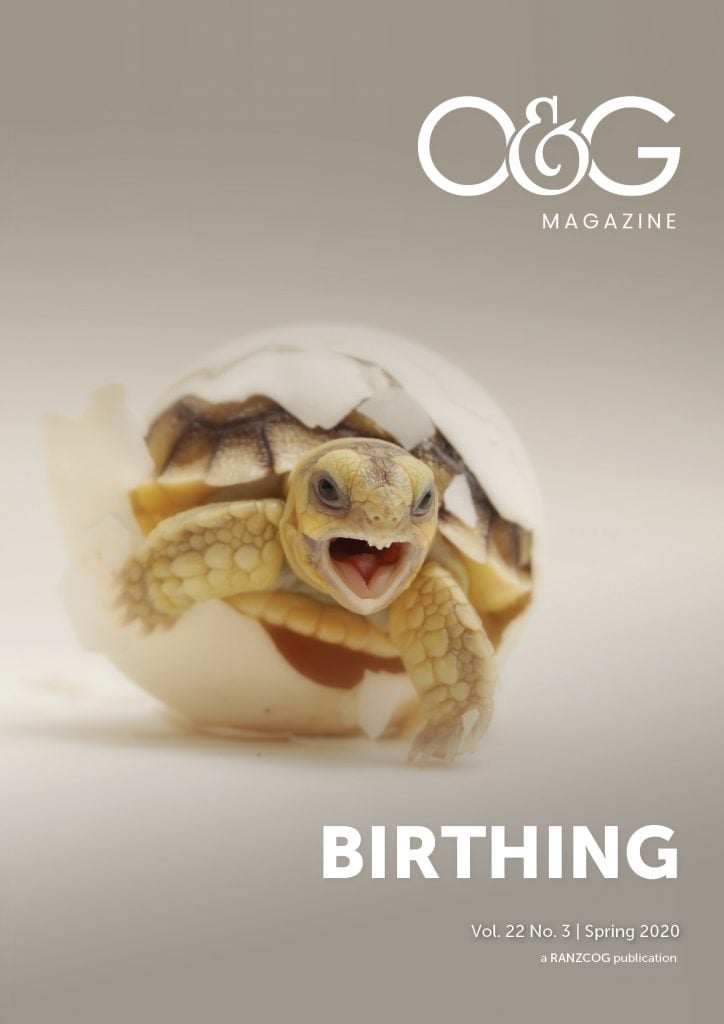The technology around the monitoring of the fetus during labour has been largely unchanged since the 1970s when some of the world’s first randomised clinical trials (RCTs) of intrapartum fetal heart rate (FHR) monitoring were conducted by Carl Wood and Peter Renou in Melbourne.1 As maternity care providers, we are all too familiar with cardiotocography (CTG) and how it remains regarded by many as the ‘gold standard’ in the field of FHR surveillance – a process we all refer to as electronic fetal monitoring (EFM). Based on Doppler ultrasound, CTG approximates FHR using an ultrasound wave of 1.5 MHz to isonate fetal heart and subsequently detects the dispersed waveforms through a transducer via the Doppler effect. We describe the FHR as being an approximate measure here since CTG uses autocorrelation techniques to compare and average Doppler waveforms to derive the FHR. Broadly speaking, the rationale that underpins EFM encompasses screening for patterns of FHR changes which occur secondary to fetal hypoxia. The intention behind this is to dynamically guide clinical decision making regarding timing of delivery in order to prevent birth asphyxia.2 3
Although CTG still remains the most widely used method of electronic intrapartum fetal surveillance in high-income countries, there are several, and widely acknowledged, limitations with it as an approach to assessing fetal wellbeing. Some have argued that it has withstood the test of time purely on the basis that there is no suitable alternative. Nonetheless, it is still somewhat surprising that there have been no meaningful advances in the technology that underpins EFM in over 60 years! We seek to change this. We have a vision of pushing the boundaries of technological innovation underpinning intrapartum EFM with the intent of improving both maternal and neonatal outcomes as well as women’s birth experiences.
Limitations of current EFM technology
One of the fundamental shortcomings of CTG is the limitation imposed by Doppler ultrasound as a technology itself.4 First, the transducer for collecting the FHR requires initial placement, frequent repositioning and subsequent supervision by a clinician. This limits mobility of the labouring woman. Next, there are issues with maternal heart rate (MHR) and FHR confusion as well as signal loss during monitoring, which occurs in as many as 15−40% of labours. Loss of signal or confusion between the MHR and FHR is particularly common in the second stage of labour. These challenges are heightened in overweight or obese women. Beyond these clinical challenges, deficiencies with the signal quality of FHR data due to the approximation process that it uses often compromises the visual outputs generated for the CTG that makes interpretation difficult. These include a lack of true beat-to-beat FHR data, signal artefacts (i.e. double and half counting of the FHR), and the inability to detect fetal arrythmias.5 6 7
However, newer technology that has become available over the last decade, such as non-invasive fetal electrocardiogram (NIFECG), offers promise in solving the clinical and technological challenges. The NIFECG obtains FHR information from the maternal abdomen and provides real time visualisation of the fetal electrophysiological process. To obtain the signal, the wireless device is simply placed on the abdomen like an adherent patch, using surface electrodes similar to those used in adult electrocardiography.8 To the clinician, the output may be visually indistinguishable to that obtained from the traditional CTG, but the advantages over the CTG are several fold. Using this, the signal loss and rate of FHR and MHR confusion, both in the first and second stage of labour, are significantly less than occurs with the CTG.9 10 The technology is also ‘BMI agnostic’, unaffected by maternal obesity, and supports full ambulation and mobility during labour.11 12 13 The ability to ‘set and forget’ the NIFECG sensor, instead of the incessant repositioning of a Doppler transducer, allows the clinician to focus more on the woman and less on the machine. A recent multicentre trial of a NIFECG confirmed that it outperforms CTG and even suggested that its closely resembled the performance measures of a fetal scalp electrode (FSE).14
Obstetric decision making: computerised CTG
RCTs have consistently failed to show that CTGs improve perinatal mortality or longer-term outcomes associated with injury, such as cerebral palsy. On the contrary, its use has been associated with an increase in obstetric intervention.15 16 Proponents of CTGs have often argued that this is largely due to poor interpretation of the CTG rather than technological deficiencies per se. There is no question that there is significant inter- and intra-observational variation in CTG interpretation, even between experts, and those experts may frequently miss the at-risk fetus.17 18 No wonder that a significant proportion of obstetric litigation involves the interpretation of the intrapartum CTG.19
So, could artificial intelligence (AI) be the answer to this very ‘human factors’ problem? Certainly, computerised CTG is an area of active research that seeks to harness machine learning and neural networks. The long-term vision of this work is a clinical decision support system that affords consistent and reliable CTG interpretation to support and inform expert obstetric decision making. Sadly, as with CTGs per se, RCTs of computerised CTG interpretation have not yet shown them to outperform ‘human eyes’. That is not to say that AI should be abandoned – ongoing refinement of the underlying algorithms continues to advance at pace, including the ability of algorithms to learn from the data itself (machine learning/deep learning) as opposed to being ‘trained’ by the clinicians. It’s just not yet ready for prime time.20 21 22
Identification of the hypoxic fetus
Irrespective of interpretation, CTGs are poor at identifying fetal acidaemia. Whether assessed by AI or by clinicians, there is an urgent need for technology with better sensitivity and specificity for hypoxaemia/acidaemia.23 24 25
ST segment analysis using FSE is one these proposed methods which is based on the premise of identifying dynamic changes in the fetal ST segments that occur in response to hypoxia to prompt delivery. Previously, high-quality evidence for invasive ST segment analysis use during labour did not suggest any advantage over routine CTG in reducing neonatal acidemia. However, a recent expert opinion piece that revaluated the evidence with respect to trial design, heterogeneity of outcomes and statistical methods suggested that it was superior to CTG in this regard.26 27 Even though the evidence is equivocal at best in this area, NIFECG allows us, for the first time, to replicate this non-invasively. There is increasing work being directed toward using this feature as well as several novel signal metrics intrapartum to identify dynamically evolving intrapartum hypoxia in the fetus. The potential applications for this to extend to the antenatal period with utility also being demonstrated in the screening for intrauterine growth restriction.28 29
Similarly, fetal blood sampling is another commonly used adjunct test to aid in the identification of the hypoxic fetus. The evidence surrounding its utility, however, is largely equivocal with some suggestion that it may reduce the number of caesarean sections when used in consort with the CTG. Much criticism has been levelled towards the test itself however, such as it being unfriendly to the patient and clinician, highly invasive, time consuming and having a high degree of inter- and intra-operator variability. This invariably affects test performance and the subsequent results that are obtained, which may serve to explain these findings. One approach to overcoming these issues is the development of biosensors that can continuously monitor fetal lactate dynamically during labour. The end goal here is a device that can be applied to the fetus transvaginally to monitor lactates continuously during labour. The results could prevent unnecessary caesarean sections or could prompt the decision to expedite birth when a critical threshold is reached. There are several approaches to developing such a lactate biosensor with several groups working on this concurrently. Most of these are in early phase studies, but we can anticipate a fully functional device capable of such functions in the near future.30 31
We hope this review helps shed some light on the current state of the art with respect to fetal monitoring during labour. We would like to reiterate that, at present, these are all considered to be investigational approaches, but with the ability to bear fruit clinically in the near future. Through this, there is a realistic possibility of improving both the clinical management of EFM, reducing unnecessary intervention and increasing the quality of the experience of birth for both mothers and clinicians. We look forward to a future where precision-based techniques can be used in our decision making and move fetal monitoring into the 21st century.
References
- Wood C, Renou P, Oats J, et al. A controlled trial of fetal heart rate monitoring in a low-risk obstetric population. Am J Obst Gynecol. 1981;141(5):527-34.
- Alfirevic Z, Devane D, Gyte GM, Cuthbert A. Continuous cardiotocography (CTG) as a form of electronic fetal monitoring (EFM) for fetal assessment during labour. Cochrane Database Syst Rev. 2017;2(2):Cd006066.
- Smith V, Arunthavanathan S, Nair A, et al. A systematic review of cardiac time intervals utilising non-invasive fetal electrocardiogram in normal fetuses. BMC Pregnancy and Childbirth. 2018;18(1):370.
- Peters CH, ten Broeke ED, Andriessen P, et al Beat-to-beat detection of fetal heart rate: Doppler ultrasound cardiotocography compared to direct ECG cardiotocography in time and frequency domain. Physiological Measurement. 2004;25(2):585-93.
- Ayres-de-Campos D, Spong CY, Chandraharan E. FIGO consensus guidelines on intrapartum fetal monitoring: Cardiotocography. Int J Gynecol Obst. 2015;131(1):13-24.
- Bakker PC, Colenbrander GJ, Verstraeten AA, Van Geijn HP. The quality of intrapartum fetal heart rate monitoring. Eur J Obst Gynecol Reprod Biol. 2004;116(1):22-7.
- Peters M, Crowe J, Pieri JF, et al. Monitoring the fetal heart non-invasively: a review of methods. Journal of Perinatal Medicine. 2001;29(5):408-16.
- Smith V, Nair A, Warty R, et al. A systematic review on the utility of non-invasive electrophysiological assessment in evaluating for intra uterine growth restriction. BMC Pregnancy and Childbirth. 2019;19(1):230.
- Reinhard J, Hayes-Gill BR, Schiermeier S, et al. Intrapartum Heart Rate Ambiguity: A Comparison of Cardiotocogram and Abdominal Fetal Electrocardiogram with Maternal Electrocardiogram. Gynecologic and Obstetric Investigation. 2013;75(2):101-8.
- Stampalija T, Signaroldi M, Mastroianni C, et al. Fetal and maternal heart rate confusion during intra-partum monitoring: comparison of trans-abdominal fetal electrocardiogram and Doppler telemetry. J Matern Fetal Neonatal Med. 2012;25(8):1517-20.
- Reinhard J, Hayes-Gill BR, Schiermeier S, et al. Intrapartum Heart Rate Ambiguity: A Comparison of Cardiotocogram and Abdominal Fetal Electrocardiogram with Maternal Electrocardiogram. Gynecologic and Obstetric Investigation. 2013;75(2):101-8.
- Euliano TY, Darmanjian S, Nguyen MT, et al. Monitoring Fetal Heart Rate during Labor: A Comparison of Three Methods. Journal of Pregnancy. 2017:8529816.
- Cohen WR, Hayes-Gill B. Influence of maternal body mass index on accuracy and reliability of external fetal monitoring techniques. Acta Obstet Gynecol Scand. 2014;93(6):590-5.
- Lempersz C, Noben L, van Osta G, et al. Intrapartum non-invasive electrophysiological monitoring: A prospective observational study. Acta Obstet Gynecol Scand. https://doi.org/10.1111/aogs.13873
- Smith V, Arunthavanathan S, Nair A, et al. A systematic review of cardiac time intervals utilising non-invasive fetal electrocardiogram in normal fetuses. BMC Pregnancy and Childbirth. 2018;18(1):370.
- Alfirevic Z, Devane D, Gyte GM. Continuous cardiotocography (CTG) as a form of electronic fetal monitoring (EFM) for fetal assessment during labour. Cochrane Database Syst Rev. 2013;5:Cd006066.
- Knupp RJ, Andrews WW, Tita ATN. The future of electronic fetal monitoring. Best Pract Res Clin Obstet Gynaecol. 2020;S1521-6934(20)30031-6.
- Farquhar CM, Armstrong S, Masson V, et al. Clinician Identification of Birth Asphyxia Using Intrapartum Cardiotocography Among Neonates With and Without Encephalopathy in New Zealand. JAMA Network Open. 2020;3(2):e1921363.
- Nowotny B, Basnayake S, Lorenz K, et al. Using medico-legal claims for quality improvement in maternity care: application and revision of an NHSLA coding taxonomy. BJOG. 2019;126(12):1437-44.
- Balayla J, Shrem G. Use of artificial intelligence (AI) in the interpretation of intrapartum fetal heart rate (FHR) tracings: a systematic review and meta-analysis. Archives of Gynecology and Obstetrics. 2019;300(1):7-14.
- Belfort MA, Clark SL. Computerised cardiotocography – study design hampers findings. Lancet. 2017;389(10080):1674-6.
- Computerised interpretation of fetal heart rate during labour (INFANT): a randomised controlled trial. Lancet. 2017;389(10080):1719-29.
- Alfirevic Z, Devane D, Gyte GM, Cuthbert A. Continuous cardiotocography (CTG) as a form of electronic fetal monitoring (EFM) for fetal assessment during labour. Cochrane Database Syst Rev. 2017;2(2):Cd006066.
- Ghi T, Chandraharan E, Fieni S, et al. Correlation between umbilical vein-to-artery delta pH and type of intrapartum hypoxia in a cohort of acidemic neonates: A retrospective analysis of CTG findings. Eur J Obst Gynecol Reprod Biol. 2018;231:25-9.
- Visser GH, Ayres-de-Campos D. FIGO consensus guidelines on intrapartum fetal monitoring: Adjunctive technologies. Int J Gynecol Obst. 2015;131(1):25-9.
- Amer-Wåhlin I, Ugwumadu A, Yli BM, et al. Fetal electrocardiography ST-segment analysis for intrapartum monitoring: a critical appraisal of conflicting evidence and a way forward. Am J Obst Gynecol. 2019;221(6):577-601.e511.
- Blix E, Brurberg KG, Reierth E, et al. ST waveform analysis versus cardiotocography alone for intrapartum fetal monitoring: a systematic review and meta-analysis of randomized trials. Acta Obstet Gynecol Scand. 2016;95(1):16-27.
- Smith V, Nair A, Warty R, et al. A systematic review on the utility of non-invasive electrophysiological assessment in evaluating for intra uterine growth restriction. BMC Pregnancy and Childbirth. 2019;19(1):230.
- Velayo CL, Funamoto K, Silao JNI, et al. Evaluation of Abdominal Fetal Electrocardiography in Early Intrauterine Growth Restriction. Frontiers in Physiology. 2017;8:437.
- Cummins G, Kremer J, Bernassau A, et al. Sensors for Fetal Hypoxia and Metabolic Acidosis: A Review. Sensors (Basel). 2018;18(8)2648.
- East CE, Leader LR, Sheehan P, et al. Intrapartum fetal scalp lactate sampling for fetal assessment in the presence of a non-reassuring fetal heart rate trace. Cochrane Database Systc Rev. 2010;(3):CD006174.









Leave a Reply